Gardening with plants native to your region is a powerful local choice that protects global biodiversity and creates an authentic sense of place. The design challenge with natives is ultimately one of imagination — we must imagine, for example, that the large green shrub with berries on it that grows in the hills or mountains 15 miles from where we live can be pruned and shaped to fit our garden.
It is completely possible to evoke an array of garden styles with native plants. All it takes is an understanding of design principles for the style you are trying to achieve, creativity in using the plant materials that you normally see growing in the wild, and the knowledge of how to maintain those plants to achieve your desired effect.
Native Plants 101
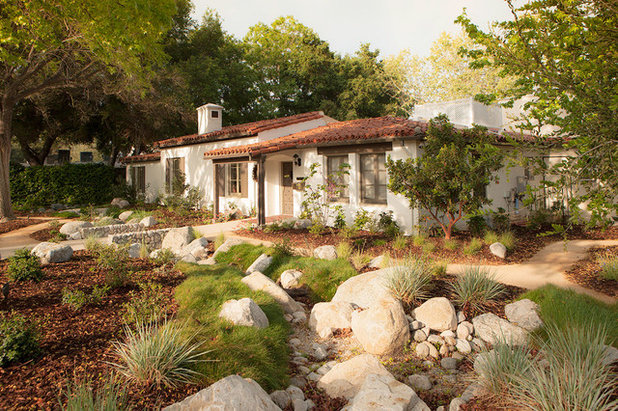
Theodore Payne Foundation
This dry creek interplanted with a mix of California native grasses directs and captures rainwater. Design by Richard Grigsby of The Great Outdoors Landscape Design & Construction.Most of us live in urban or suburban areas, where our landscapes have a visual impact on many other people, and it’s important to utilize design principles when creating your native garden. In the end, you will be much happier with the result.
As a general rule of thumb, almost all beautiful landscapes utilize repetition of the same species, or a variation of the same species, to create a sense of cohesion and harmony. You’ll notice lots of repetition in gardens designed by Mother Nature too. By picking one or two plants to repeat throughout your native landscape — among your other plants — you will create a sense of calm and order.
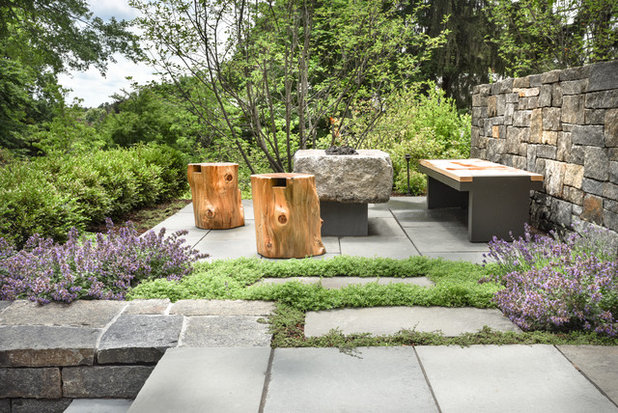
Matthew Cunningham Landscape Design LLC
Basic Garden StylesIf you are in the position of creating a native garden from scratch, here are some stylistic approaches to consider as you plan. These principles are also helpful to keep in mind when editing or updating an existing garden. Your landscape style choice might be influenced by the architecture of your home, the history of your area or garden spaces you find inspiring.
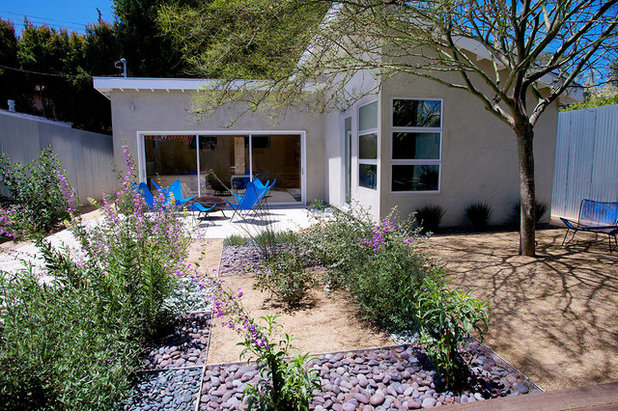
Theodore Payne Foundation
This modernist backyard utilizes clean, delineated hardscape materials of gravel, decomposed granite and concrete. Native penstemons are planted in squares, while a palo verde tree casts delicate shadows on the decomposed granite. Young ceanothus is planted as a screen against an aluminum fence.Modern. An architectural or a more modern design emphasizes plant shapes and foliage textures over flowers — though you can certainly include flowering plants. A key rule of thumb is to keep the number of plant species you are using to a minimum. Less is more. That doesn’t mean you can’t create a garden that feels full, alive and lush. Rather, it means choosing a minimalist palette of three to five species of plants, for example, and repeating them throughout the space.
Pick plants that are well-scaled to the space: For a small space, pick smaller native grasses, ground covers and shrubs that reach a mature size no larger than 4 feet tall and wide. If you have the space, one courtyard-size tree or large shrub pruned into a tree can be a nice focal point or shade creator. For larger areas, you can pick larger-scale plants, but stick to the principle of a restrained palette with an emphasis on plant foliage.

Cassy Aoyagi, FormLA Landscaping
The red tubular flowers of California native snapdragon dangle over square pavers here, with a fine gravel neatly edging the path. Negative space is an important part of architectural landscape design. This means leaving some empty space for the eye to rest between, in front of or around and behind plants. Negative space can be created with low-growing native ground cover plants or with inorganic materials such as gravel or mulch. Spacing your plants so you can see the full shape of each plant is another way to utilize negative space. Create a sense of spaciousness by shaping hardscape areas, such as walkways or seating areas, with clearly defined lines.
Read more about modern garden style
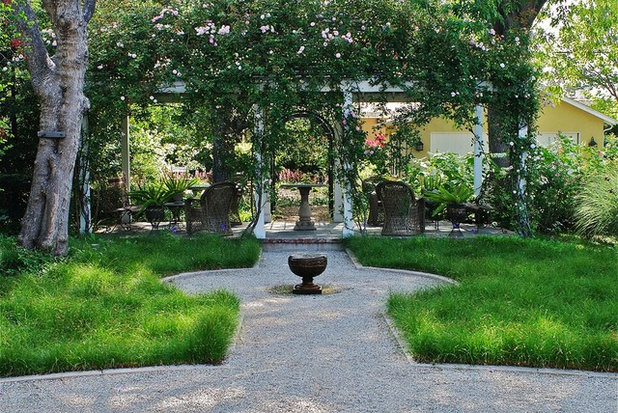
Theodore Payne Foundation
Dune sedge (Carex pansa) makes for a lovely ground cover and provides plenty of space for the eye to rest in this classical garden designed by Wynne Wilson.Classical. Classical garden style emphasizes balance, proportions and symmetry, and evokes the ancient architecture of Greece and Italy. This effect can be achieved with native plants — just be sure to use a limited plant palette and consider plants that can be pruned into more formal shapes, such as rounded shrubs, boxy hedges or columnar plantings. In Southern California, Catalina cherry (
Prunus ilicifolia lyonii), native to the Channel Islands, makes an excellent formal hedge.
Read more about classical garden style
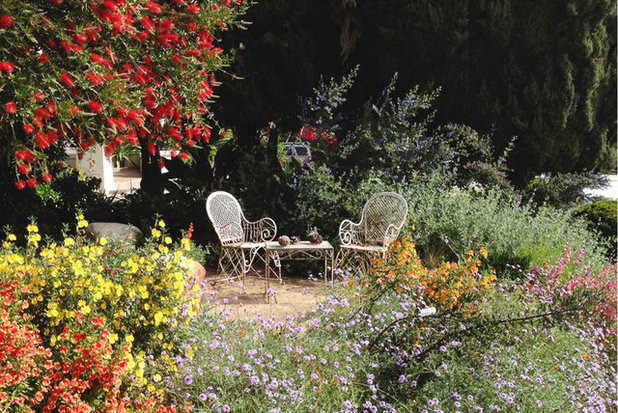
Theodore Payne Foundation
The purple flowers of Cedros Island verbena (Verbena lilacina) mix with vibrant yellow and orange monkey flowers (Diplacus sp.) and vibrant pink Clarkia wildflowers in this California native cottage garden. An Australian native bottlebrush tree provides a vibrant red nectar source for hummingbirds nearly year-round.
Cottage. A native cottage garden evokes a sense of abundance, emphasizing a profusion of color and blooms and including numerous plant species with different textures. This style allows for a more diverse plant palette and is achieved by planting to fill a garden space. For example, you’ll want to know that the mature size of a ceanothus is 10 feet by 10 feet, and space the next plant roughly 5 feet from the center of your ceanothus.
There is less emphasis on negative space in a cottage garden, though carving out spaces for the eye to rest can still be beneficial. Use warm, rustic materials for hardscapes, such as aged wood for fencing and aged brick or stone for a walkway, and incorporate garden objects that draw the eye to important areas of your garden. Vintage garden furniture also makes an excellent complement to a native cottage garden.
Wildflowers absolutely lend themselves to a cottage garden. There is no sweeter way to evoke an authentic sense of place than by sowing seeds for wildflowers that are native to your area — you may even discover some beauties you’ve never seen before. Just be sure to balance your seasonal wildflowers with perennial shrubs that look more or less the same year-round, so your garden doesn’t look too barren when the wildflowers disappear.
Read more about cottage garden style
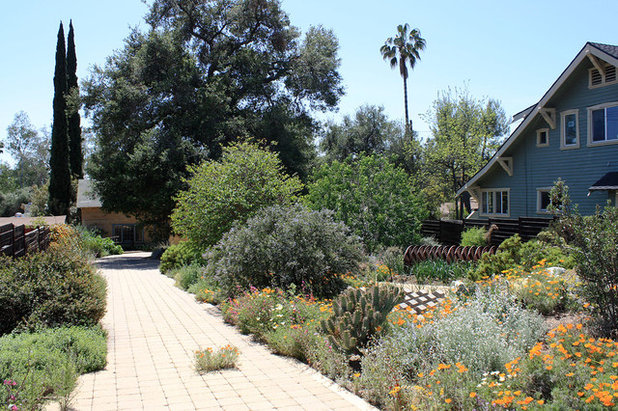
Theodore Payne Foundation
Andreas Hessing of Scrub Jay Studios designed this eclectic, semiformal collector’s garden.
Eclectic. An eclectic garden by definition is a combination of other styles. Going for an eclectic look can free you up to express your taste and personality. But eclectic can quickly slide into chaotic if design principles are not followed.
Be sure to use repetition of the same plants for a sense of harmony, and avoid an overly long list of plants. And includes places for the eye to rest, such as hardscapes or ground covers. Try to create a theme for the objects in your landscape to prevent a sense of randomness. But have fun with introducing unexpected elements. Rules, after all, are meant to be broken sometimes.
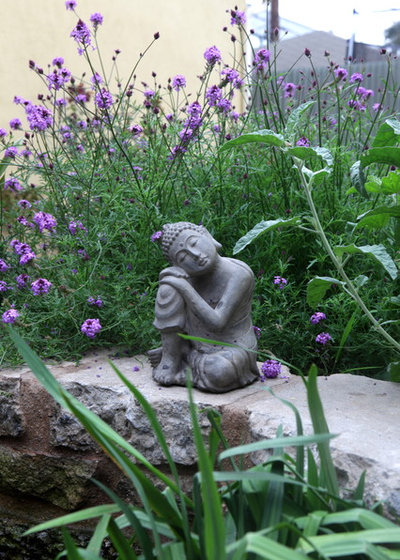
Cassy Aoyagi, FormLA Landscaping
A calming Buddhist statue sits atop a recycled-concrete garden wall in front of vibrant purple Cedros Island verbena (Verbena lilacina). There are numerous variations on each of these styles, and you can celebrate your own cultural heritage or the history of your region by incorporating objects or stylistic accents that have symbolic meaning and significance.
Next: Maintaining your native garden





